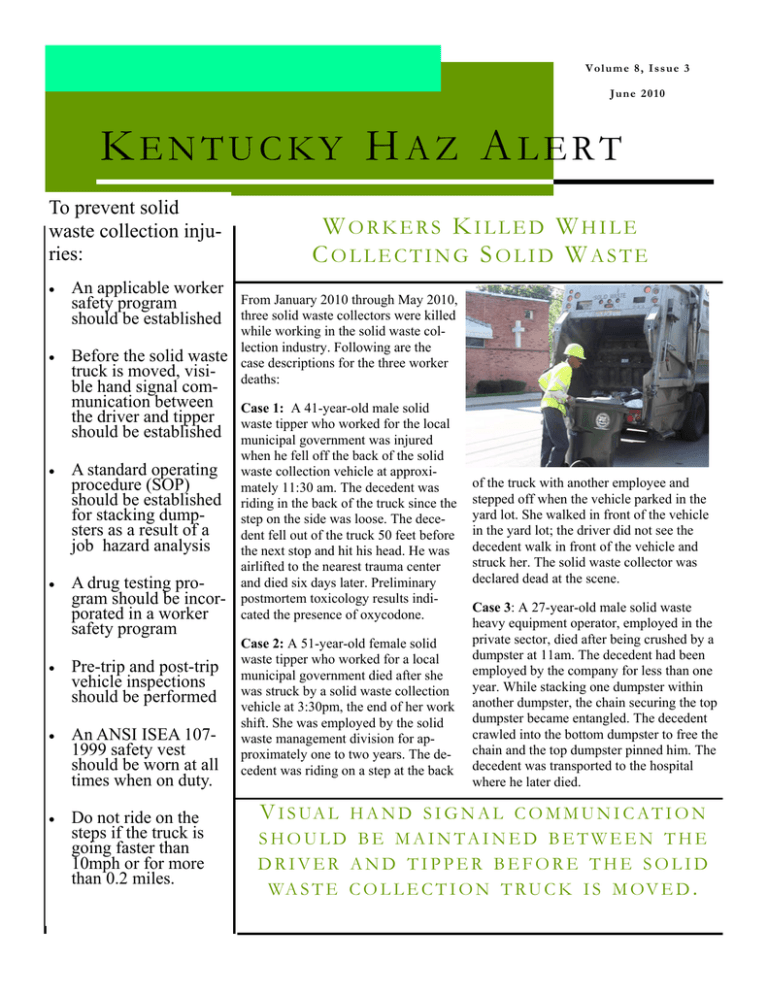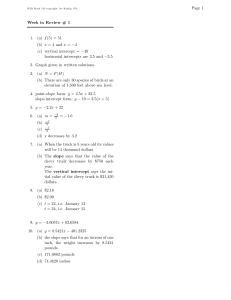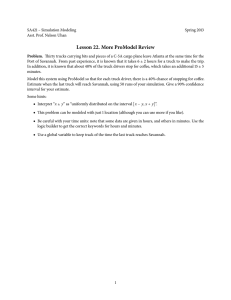W K C
advertisement

Volume 8, Issue 3 June 2010 KENTUCKY HAZ ALERT To prevent solid waste collection injuries: • An applicable worker safety program should be established • Before the solid waste truck is moved, visible hand signal communication between the driver and tipper should be established • • A standard operating procedure (SOP) should be established for stacking dumpsters as a result of a job hazard analysis A drug testing program should be incorporated in a worker safety program • Pre-trip and post-trip vehicle inspections should be performed • An ANSI ISEA 1071999 safety vest should be worn at all times when on duty. • Do not ride on the steps if the truck is going faster than 10mph or for more than 0.2 miles. WORKERS KILLED WHILE COLLECTING SOLID WASTE From January 2010 through May 2010, three solid waste collectors were killed while working in the solid waste collection industry. Following are the case descriptions for the three worker deaths: Case 1: A 41-year-old male solid waste tipper who worked for the local municipal government was injured when he fell off the back of the solid waste collection vehicle at approximately 11:30 am. The decedent was riding in the back of the truck since the step on the side was loose. The decedent fell out of the truck 50 feet before the next stop and hit his head. He was airlifted to the nearest trauma center and died six days later. Preliminary postmortem toxicology results indicated the presence of oxycodone. Case 2: A 51-year-old female solid waste tipper who worked for a local municipal government died after she was struck by a solid waste collection vehicle at 3:30pm, the end of her work shift. She was employed by the solid waste management division for approximately one to two years. The decedent was riding on a step at the back of the truck with another employee and stepped off when the vehicle parked in the yard lot. She walked in front of the vehicle in the yard lot; the driver did not see the decedent walk in front of the vehicle and struck her. The solid waste collector was declared dead at the scene. Case 3: A 27-year-old male solid waste heavy equipment operator, employed in the private sector, died after being crushed by a dumpster at 11am. The decedent had been employed by the company for less than one year. While stacking one dumpster within another dumpster, the chain securing the top dumpster became entangled. The decedent crawled into the bottom dumpster to free the chain and the top dumpster pinned him. The decedent was transported to the hospital where he later died. V I S UA L H A N D S I G N A L C O M M U N I C A T I O N SHOULD BE MAINTAINED BETWEEN THE DRIVER AND TIPPER BEFORE THE SOLID WA S T E C O L L E C T I O N T R U C K I S M OV E D . K e n t u ck y H a z A l e r t AN APPLICABLE WORKER SAFETY PROGRAM SHOULD BE ESTABLISHED An applicable worker safety program should be established that contains basic elements such as the use of personal protective equipment (29 CFR 1910.132), first aid (29 CFR 1910.151), bloodborne pathogens (29 CFR 1910.1030), fire extinguishers (29 CFR 1910.157), and appropriate ANSI standards for solid waste collection (e.g. ANSI Z245.12008). BEFORE THE SOLID WASTE TRUCK IS MOVED, HAND SIGNAL COMMUNICATION BETWEEN THE DRIVER AND TIPPER SHOULD BE E S TA B L I S H E D Visual hand communication should be maintained at all times between the driver and the tipper(s). A STANDARD OPERATING PROCEDURE (SOP) SHOULD BE ESTABLISHED FOR STACKING DUMPSTERS AS A RESULT OF A JOB HAZARD ANALYSIS A job hazard analysis should be completed on all job activities performed by employees within the company. Each job should be reviewed to identify possible hazards, and should contain procedures to eliminate or control each potential hazard. DRUG TESTING SHOULD BE INCORPORATED INTO A WORKER SAFETY PROGRAM Comprehensive expanded new-hire prescreening Page 2 and after-hire random drug policies should be implemented and enforced for substance abuse. PRE-TRIP AND POST-TRIP VEHICLE INSPECTIONS SHOULD BE PERFORMED Employers should require drivers to perform pre-trip and post-trip inspections on the solid waste truck prior to operation. In one of the cases, the decedent was illiterate. If the employee cannot read, then a verbal report on the condition of the truck should be communicated with the supervisor. Federal Motor Carrier Safety Administration regulations CFR 396.13, 396.9, and CFR 396.11 require commercial motor vehicles to be inspected before driving the vehicle, and at the completion of the day’s work. CFR 396.3 pertains to recordkeeping, repair, and maintenance. AN ANSI/ISEA 107-1999 SAFETY VEST SHOULD BE WORN AT ALL TIMES WHEN ON DUTY. A policy should be designed, developed and enforced regarding the use of ANSI/ISEA 107-19999 safety vests at all times while on duty (ABSI Z245.1-2008) . DO NOT RIDE ON THE STEPS IF THE TRUCK IS GOING FASTER THAN 10 MPH OR FOR MORE THAN 0.2 MILES For more information, contact: KY Fatality Assessment & Control Evaluation (FACE) Program, Kentucky Injury Prevention and Research Center (KIPRC) 333 Waller Ave., Suite 242 Lexington, KY 40504 1-800-204-3223 (toll-free) http://www.kiprc.uky.edu/face.html References: 1. Kentucky Fatality Assessment and Control Evaluation report # 06KY100, “Coal truck driver dies in rollover after tire on trailer fails.” 2. New York Fatality Assessment and Control Evaluation report #02NY007, “Truck driver run over by trash compactor at municipal landfill.” 3. Waste Age Magazine http://wasteage.com which offers free access and free safety and health information The KY FACE program is an occupational fatality program at KIPRC funded by the National Institute for Occupational Safety and Health (NIOSH) (Cooperative Agreement No.: 5 U60 OH008483-05.





